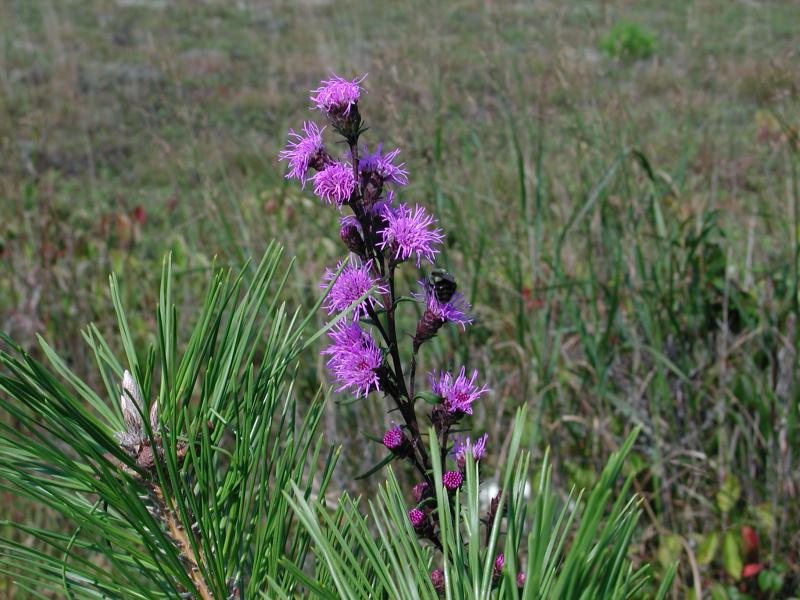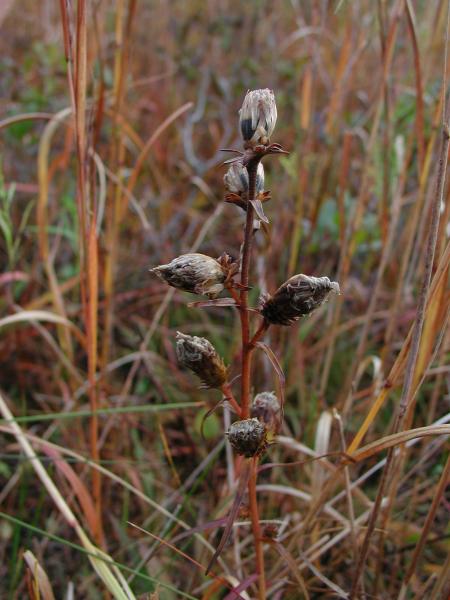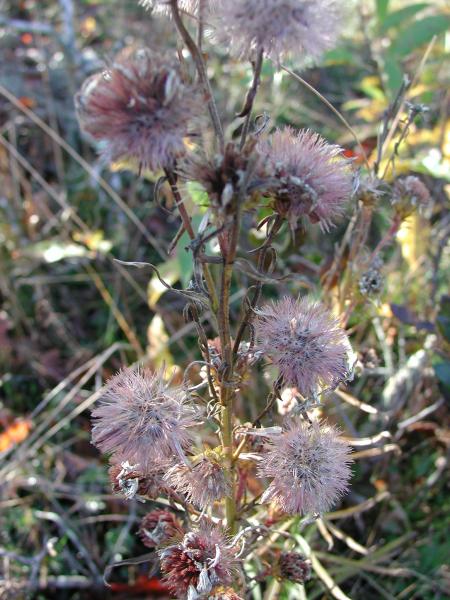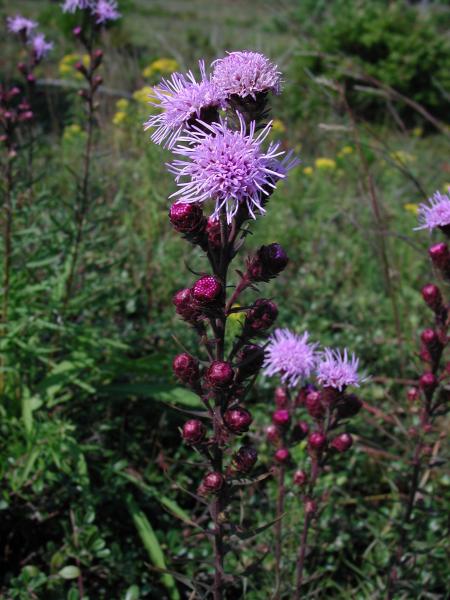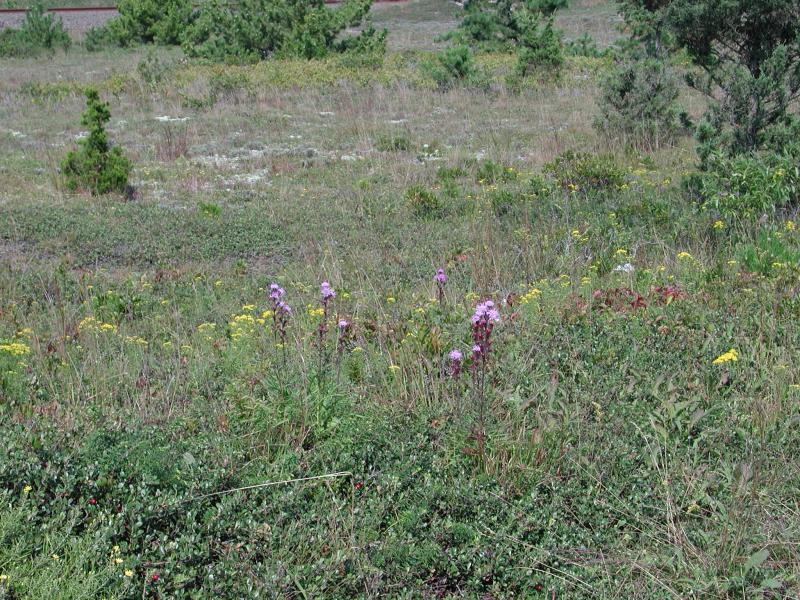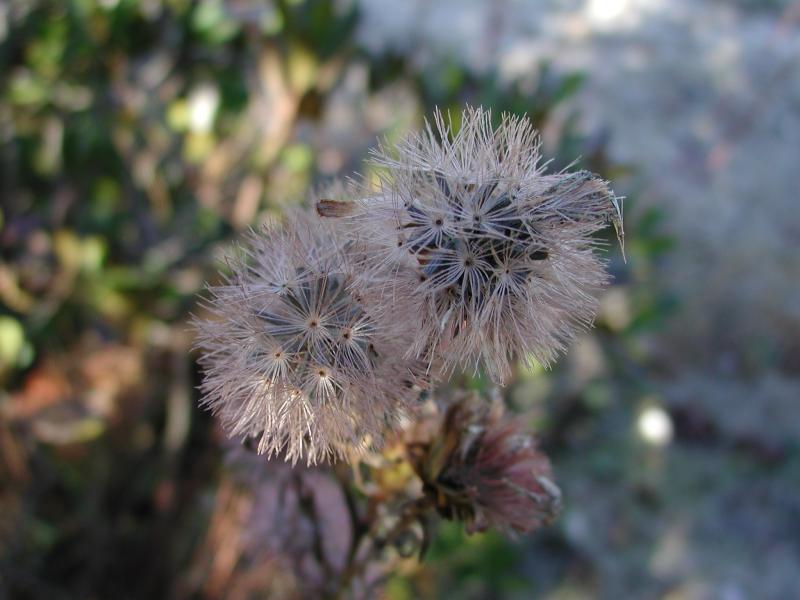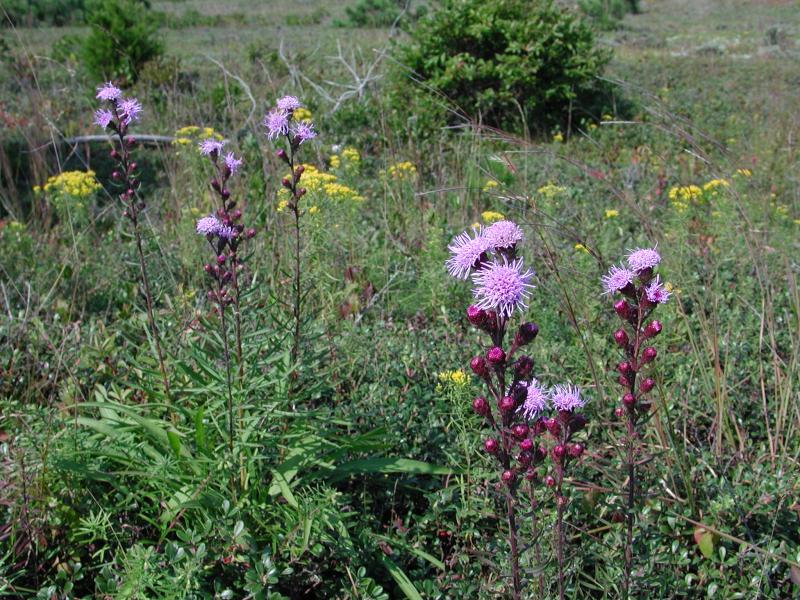Northern Blazing Star
Liatris scariosa var. novae-angliae (Lunell) Gandhi, S.M. Young & P. Somers
- Class
- Dicotyledoneae (Dicots)
- Family
- Asteraceae (Aster Family)
- State Protection
- Threatened
Listed as Threatened by New York State: likely to become Endangered in the foreseeable future. For animals, taking, importation, transportation, or possession is prohibited, except under license or permit. For plants, removal or damage without the consent of the landowner is prohibited.
- Federal Protection
- Not Listed
- State Conservation Status Rank
- S2
Imperiled in New York - Very vulnerable to disappearing from New York due to rarity or other factors; typically 6 to 20 populations or locations in New York, very few individuals, very restricted range, few remaining acres (or miles of stream), and/or steep declines.
- Global Conservation Status Rank
- G5?T3
Vulnerable globally - The subspecies/variety is at moderate risk of extinction due to rarity or other factors; typically 80 or fewer populations or locations in the world, few individuals, restricted range, few remaining acres (or miles of stream), and/or recent and widespread declines. (The species as a whole is most likely common globally.)
Summary
Did you know?
The number and range of this plant has been greatly reduced on Long Island as development has reduced its open upland habitat. An interesting naming problem occurred with this variety as the name Liatris scariosa var. novae-angliae (meaning New England) was being used in botany manuals without first being formally published. This was corrected in 2003 with a formal recognition of the name. The origin of the name Liatris is unknown.
State Ranking Justification
There are 19 existing populations but only four of these are in good condition. The rest are usually less than 100 plants each in small grassland or roadside habitats. There are approximately 30 historical occurrences but about 10 of these have been extirpated in Western Long Island and Westchester County.
Short-term Trends
The short-term trend seems stable although a few populations were extirpated by habitat alteration in recent years.
Long-term Trends
The long-term trend has been declining over the last 100 years as grassland habitats have become more fragmented by human development. There are only a few populations that remain in fairly large grasslands as others have held on in smaller grassland fragments or along roadsides. The 10 or so historical occurrences from Western Long Island, New York city and Westchester County are considered extirpated.
Conservation and Management
Threats
These plants may be lost to succession if the grassland communities are not maintained, preferrably by fire management. Roadside populations are threatened by improper mowing schedules which remove plants before they can disperse seed or by maintenance which can destroy plants. Some plants are threatened by house construction or by picking for flower arrangements. More study needs to be done to see if plants are being over-browsed by deer. Without periodic fires moth larvae eat the seeds of Liatris and reduce reproduction (Vickery 2002, Kane 2001).
Conservation Strategies and Management Practices
Grassland habitats need to be kept open by mowing, grazing, or preferrably by prescribed fires which increase seed production for (Vickery 2002, Kane 2001). Mowing schedules should avoid direct damage to plants. High dispersal populations can be targeted for management efforts to promote regeneration (Gravuer 2003).
Research Needs
More research is needed into maintenance techniques that will preserve and augment populations. Deer browse studies are needed to determine their effect (Kane 2001).
Habitat
Habitat
In New York State this species occupies dry, sandy habitats, usually grasslands or grassy openings. Many of the extant sites are maritime grasslands, or grassy openings within maritime heathlands, though it also will inhabit open rocky summits, as well as artificially disturbed, weedy grasslands on sandy roadsides (New York Natural Heritage Program 2007). Prairies, open woods, and other dry, open places (Gleason and Cronquist 1991). Dry argillaceous to siliceous open woods, thickets, and clearings (Fernald 1970).
Associated Ecological Communities
- Farm pond/artificial pond
The aquatic community of a small pond constructed on agricultural or residential property. These ponds are often eutrophic, and may be stocked with panfish such as bluegill and yellow perch.
- Maritime grassland*
(guide)
A grassland community that occurs on rolling outwash plains of the glaciated portion of the Atlantic coastal plain, near the ocean and within the influence of offshore winds and salt spray.
- Maritime heathland
(guide)
A dwarf shrubland community that occurs on rolling outwash plains and moraine of the glaciated portion of the Atlantic coastal plain, near the ocean and within the influence of onshore winds and salt spray.
- Mowed roadside/pathway
A narrow strip of mowed vegetation along the side of a road, or a mowed pathway through taller vegetation (e.g., meadows, old fields, woodlands, forests), or along utility right-of-way corridors (e.g., power lines, telephone lines, gas pipelines). The vegetation in these mowed strips and paths may be dominated by grasses, sedges, and rushes; or it may be dominated by forbs, vines, and low shrubs that can tolerate infrequent mowing.
- Red cedar rocky summit*
(guide)
A community that occurs on warm, dry, rocky ridgetops and summits where the bedrock is calcareous (such as limestone or dolomite, but also marble, amphibolite, and calcsilicate rock), and the soils are more or less calcareous. The vegetation may be sparse or patchy, with numerous lichen covered rock outcrops.
* probable association but not confirmed.
Associated Species
- Arctostaphylos uva-ursi (bearberry)
- Cirsium horridulum
- Myrica pensylvanica
- Nuttallanthus canadensis (old-field-toad-flax)
- Panicum virgatum (switch grass)
- Pinus rigida (pitch pine)
- Pityopsis falcata (sickle-leaved golden-aster)
- Prunus maritima (beach plum)
- Quercus alba (white oak)
Range
New York State Distribution
In New York Northern Blazing-star has been found only on Long island and in Dutchess County in the Hudson Valley.
Global Distribution
Liatris scariosa var. novae-angliae is found in each of the New England states as well as New York, New Jersey, and Pennsylvania.
Identification Comments
General Description
Northern Blazing-star is a perennial herb of the Aster family, growing up to 1.2 m tall. Its leaves are long (11 to 27 cm), narrow (.5 to 2.5 cm), and glabrous or minutely hairy. There are 5 to 30 flowering heads of disc flowers only, each on a peduncle 1-5 cm long. The flowers (35-60 per head) are a bright (blazing) pink, and tube-shaped, lending the heads a distinctive "shaggy" appearance.
Best Life Stage for Proper Identification
This species is most easily spotted and identified when in flower, though it may be identified when fruiting as well.
Similar Species
L. scariosa var. angliae and L. cylindracea are the only Liatris species native in New York, and the only ones with the flowering heads on pedicels as long as the involucres. Liatris cylindracea differs from Liatris scariosa var. novae-angliae by its linear leaves (normally no more than 6 mm wide), and glabrous stem, and is a Midwestern species known in New York only from Niagara County.
Best Time to See
Northern Blazing-star flowers and fruits in late summer, and may persist until frost.
- Flowering
- Fruiting
The time of year you would expect to find Northern Blazing Star flowering and fruiting in New York.
Northern Blazing Star Images
Taxonomy
Northern Blazing Star
Liatris scariosa var. novae-angliae (Lunell) Gandhi, S.M. Young & P. Somers
- Kingdom Plantae
- Phylum Anthophyta
- Class Dicotyledoneae
(Dicots)
- Order Asterales
- Family Asteraceae (Aster Family)
- Order Asterales
- Class Dicotyledoneae
(Dicots)
- Phylum Anthophyta
Additional Common Names
- New England Blazing-star
Synonyms
- Liatris borealis auct. non Nutt.
- Liatris novae-angliae (Lunell) Shinners
- Liatris scariosa var. novae-angliae Lunell
Additional Resources
Best Identification Reference
Flora of North America Editorial Committee. 2006. Flora of North America North of Mexico. Vol. 21. Magnoliophyta: Asteridae, Part 8: Asteraceae, part 3. Oxford Univ. Press, New York. xxii + 616 pp.
Other References
Clemants, Steven and Carol Gracie. 2006. Wildflowers in the Field and Forest. A Field Guide to the Northeastern United States. Oxford University Press, New York, NY. 445 pp.
Fernald, M.L. 1950. Gray's manual of botany. 8th edition. D. Van Nostrand, New York. 1632 pp.
Gandhi, Kanchi N., Stephen M. Young and Paul Somers. 2003. A reassessment of the taxonomy and nomenclature of Liatris borealis Nutt. ex J. McNab and Lacinaria scariosa var. novae-angliae Lunell (Asteraceae). Taxon 52(2), May, pp. 313-317.
Gleason, Henry A. and A. Cronquist. 1991. Manual of Vascular Plants of Northeastern United States and Adjacent Canada. The New York Botanical Garden, Bronx, New York. 910 pp.
Gravuer, Kelly, Eric J. von Wettberg, and Johanna Schmitt. 2003. Dispersal Biology of Liatris Scariosa Var. Novae-angliae (Asteraceae), a Rare New England Grassland Perennial. American Journal of Botany 90 (8): 1159-1167.
Haines, Arthur and Thomas F. Vining. 1998. Flora of Maine. A Manual for Identification of Native and Naturalized Vascular Plants of Maine.
Holmgren, Noel. 1998. The Illustrated Companion to Gleason and Cronquist's Manual. Illustrations of the Vascular Plants of Northeastern United States and Adjacent Canada. The New York Botanical Garden, Bronx, New York.
Kane, Ailene. 2001. Liatris borealis Nuttall ex MacNab (Northern Blazing-star). New England Plant Conservation Program Conservation and Research Plan. New England Wildflower Society, Framingham, Massachusetts.
Nesom, Guy L. 2005. Infrageneric Classification of Liatris (Asteraceae: Eupatorieae). Sida 21(3): 1305-1321.
New York Natural Heritage Program. 2010. Biotics database. New York Natural Heritage Program. New York State Department of Environmental Conservation. Albany, NY.
New York Natural Heritage Program. 2024. New York Natural Heritage Program Databases. Albany, NY.
Newcomb, Lawrence. 1977. Newcomb's Wildflower Guide: An Ingenious New Key System for Quick, Positive Field Identification of the Wildflowers, Flowering Shrubs, and Vines of Northeastern and North-Central North America. Little, Brown and Company. Boston.
The Nature Conservancy. 1995. The Case of Liatris the Missing Seeds Mysteries. Maine Legacy, Newsletter of the Maine Chapter of The Nature Conservancy, Winter 1995, pp. 4-6.
Vickery, Peter. 2002. Effects of Prescribed Fire on the Reproductive Ecology of Northern Blazing-star Liatris scariosa var. novae-angliae. American Midland Naturalist 148: 20-27.
Weldy, T. and D. Werier. 2010. New York flora atlas. [S.M. Landry, K.N. Campbell, and L.D. Mabe (original application development), Florida Center for Community Design and Research http://www.fccdr.usf.edu/. University of South Florida http://www.usf.edu/]. New York Flora Association http://newyork.plantatlas.usf.edu/, Albany, New York
Weldy, Troy W. and David Werier. 2005. New York Flora Atlas. [S.M. Landry, K.N. Campbell, and L.D. Mabe (original application development), Florida Center for Community Design and Research. University of South Florida]. New York Flora Association, Albany, NY. Available on the web at (http://newyork.plantatlas.usf.edu/).
Links
About This Guide
Information for this guide was last updated on: December 11, 2008
Please cite this page as:
New York Natural Heritage Program. 2024.
Online Conservation Guide for
Liatris scariosa var. novae-angliae.
Available from: https://guides.nynhp.org/northern-blazing-star/.
Accessed July 26, 2024.
